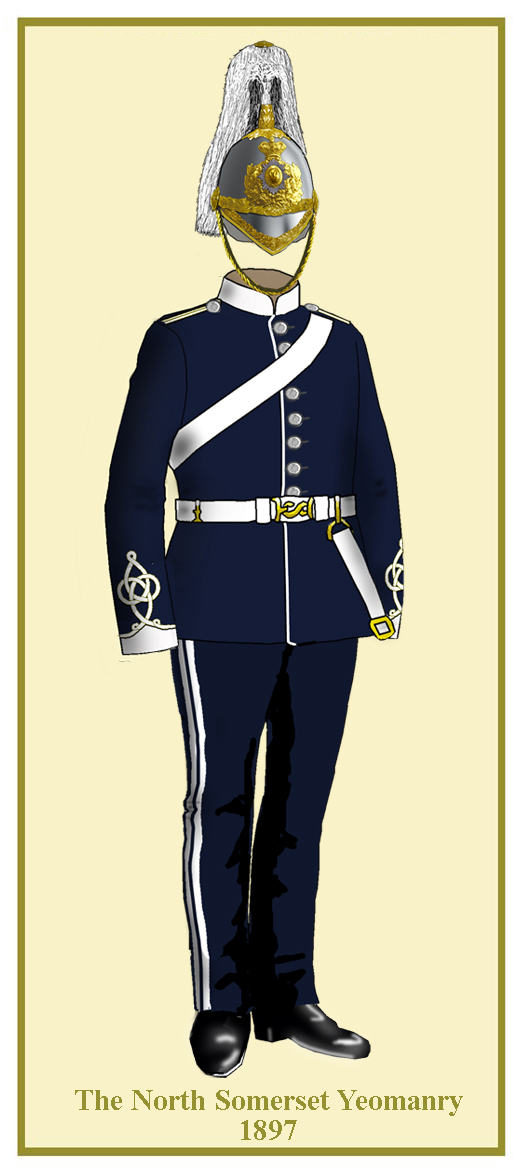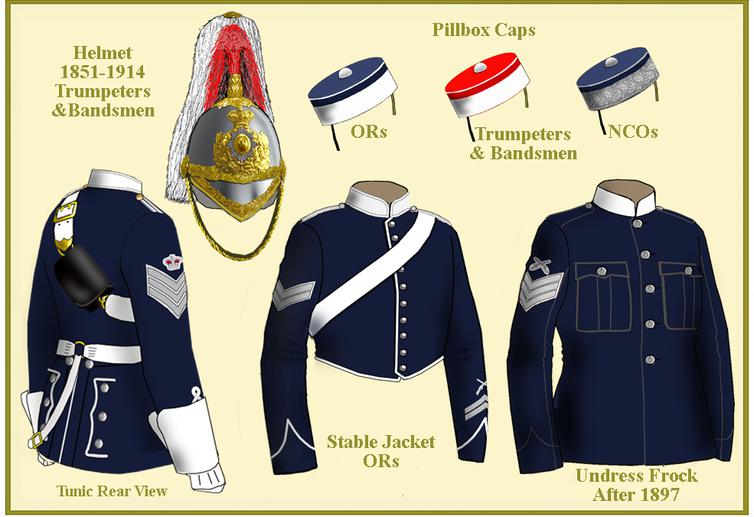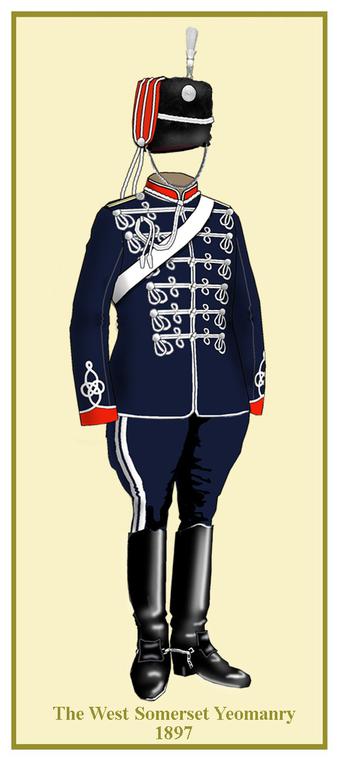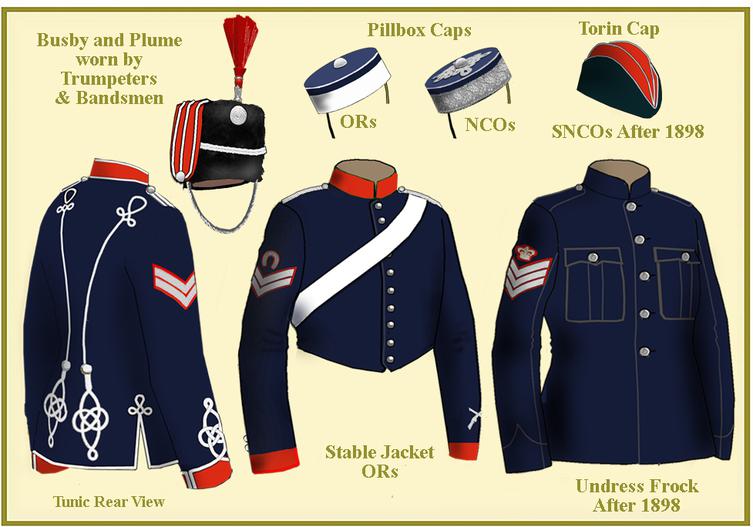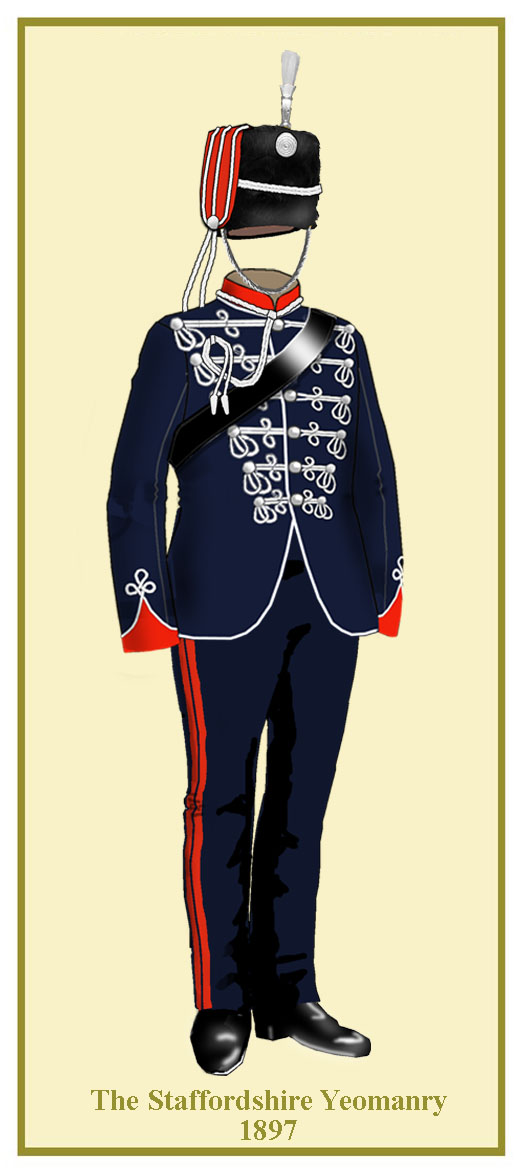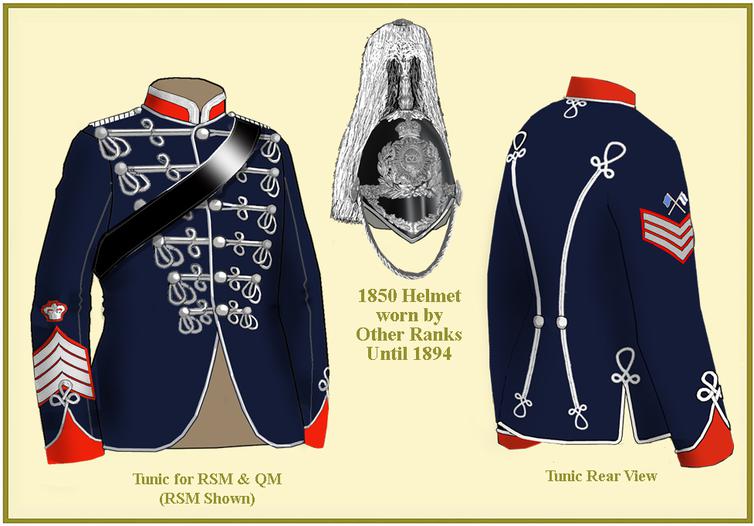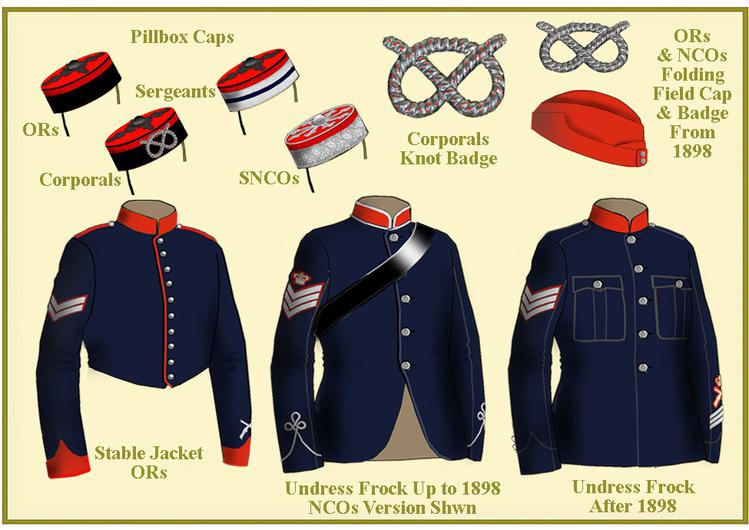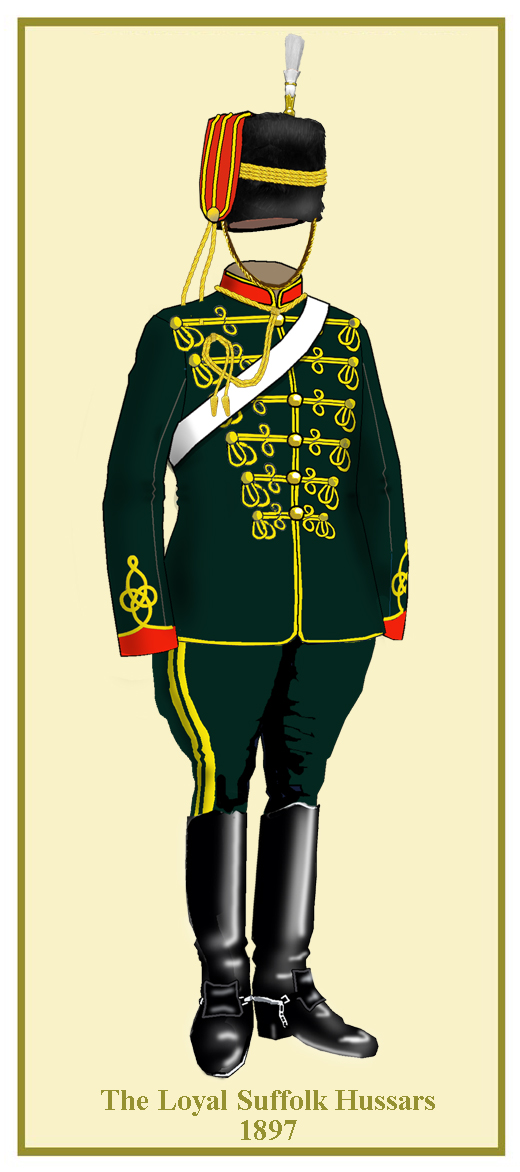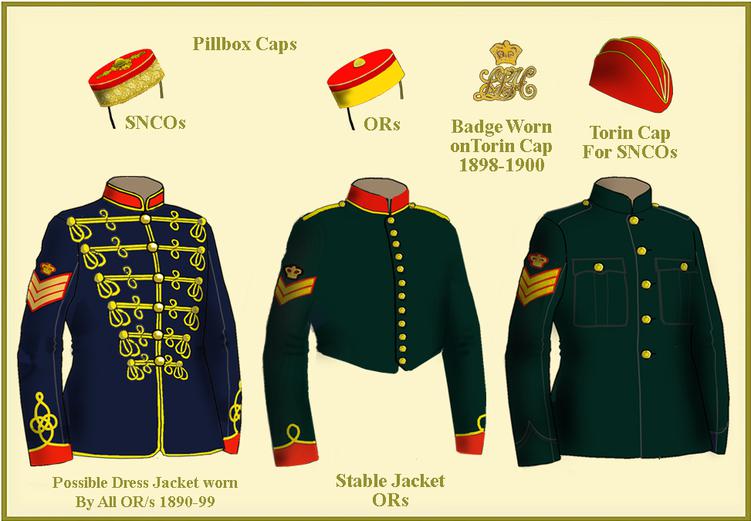The North Somerset Yeomanry
Ranked No. 11 in Yeomanry Order of preference
The North Somerset Yeomanry was first raised in Frome in 1798. There was a 10 mile restriction on its terms of service and was disbanded in 1802. Reformed in 1803 it was merged with The East Mendip Corps in 1804, and designated the North Somerset Yeomanry Cavalry in 1814 and headquartered in Bath. The HQ was moved back to Frome in 1820 and for the next twenty five years the regiment dealt with civil unrest like the rest of the Yeomanry of the era. In 188 the regiment was designated as a dragoon regiment.
Formed 48th Coy of 7th Bn Imperial Yeomanry in 1900
UNIFORMS OF THE BRITISH YEOMANRY REGIMENTS 1895-1900
PART 8
Uniforms
Only the Frome troop left information on its uniform which was blue with buff facings and netherwear. The headdress was the Tarleton helmet. Willson’s list of 1808 gives the Frome and East Mendip troop and the Bath troop as having Red jackets with black facings and presumably the Tarleton helmet. Lace was silver for both troops. By 1820 the combined troops were wearing a dark blue light dragoon jacket with red plastron, collar and pointed cuffs. The padded red wings were edged white for men and with silver chain lace for officers and a yellow and crimson striped girdle was worn. The French grey trousers had red stripes and the Tarleton helmet continued to be worn with black bearskin crest, leopard skin turban and white plume. In the 1830s the wings were replaced with shoulder scales and the trousers had become dark blue with a red stripe down each leg. It would be 1842 when the old Tarleton helmet was replaced with a black shako. In 1851 the shako was replaced with a white metal Albert pattern helmet with gilt fittings and black plume. The jacket now had two rows of white metal buttons down the front in line with contemporary light dragoon fashion. The collar and cuffs were red, the former with two white loops and buttons, and the piping on the rear seams of the jacket was also red. Other ranks wore shoulder scales and the yellow/crimson girdle remained. The trousers had double red stripes and white gauntlets were worn.
The jacket was replaced in 1856 with a dark blue light dragoon tunic piped white all around the front and collar and there were four loops across the front ending either side in Austrian knots. The cuffs had white single loops with large eye. Only the collar was red. The trousers had double red stripes and the helmet now had a white horsehair plume (the band had a white over red plume). In 1879, the tunic became of more of a hussar style with six loops across the front with conventional caps and drops fastened with olivets and the trousers had double white stripes instead of red.
A complete change occurred in 1888 when the regiment adopted a uniform modeled almost exactly on that of the 6th Dragoon Guards (Carabiniers) with white instead of yellow piping. The blue tunic had white collar and cuffs and the piping on the collar, front and rear skirt flaps were also white as were the Austrian knots (with extra dragoon eyes) on the sleeves. NCOs had silver badges and rank chevrons on white backgrounds. Silver good conduct stripes were worn on the left lower sleeve. The helmet remained the same as before. Pantaloons with double white stripes and knee boots were issued in 1890.
For undress a blue stable jacket was worn with white collar and piping around the front and bottom of the jacket, on the pointed cuffs and also round the collar. Senior NCOs had white collar and cuffs with ½” silver edging continuing down the front and bottom of jacket. In 1897 the stable jacket was replaced with a blue five buttoned frock with breast pockets and self-coloured shoulder straps and white collar. In 1900 shoulder chains were adopted. Pill boxes were blue with white band, piping and button for other ranks (red for trumpeters and bandsmen) and silver oak leaf lace for NCOs.
The blue dragoon uniform was withdrawn in 1900 and the blue frock was worn in all orders of dress and with blue puttees for mounted duties. In 1905 a khaki serge kit was introduced with white trefoils on the cuffs and piping down the sides of the breeches. A khaki slouch hat was also worn with brown leather band and white over red tuft on the right side. A blue staff pattern cap with white band and piping was adopted in 1906 and with the blue frock and white striped overalls served as full dress at the coronation of 1911.
The West Somerset Yeomanry
Ranked No. 33 in Yeomanry Order of preference
The West Somerset Yeomanry was first raised in June 1794 as an independent troop at Bridgwater. Three more troops from Wells, Taunton and the Selwood Forest Legion followed in 1794 before being regimented in 1798 as the West Somersetshire Regiment of Yeomanry Cavalry. They served without pay from 1828 to 1831, without ever being disbanded. At some point before 1872 the corps was confirmed as the West Somerset Yeomanry with Headquarters at Taunton.
Formed 2nd Coy of 7th Bn Imperial Yeomanry in 1900
Uniforms
Most of the West Somerset troops were dressed in a similar manner to the North Somerset Yeomanry. The Wells and West Somerset troops wore red with black facings and the East Coker and East Somerset troops wore Light Blue jackets also with black facings. Tarleton helmets were worn by all. By the 1820s the consolidated corps were dressed as light dragoons with blue jackets, scarlet facings and light blue trousers. They were distinguished from their Northern corps with gold lace instead of silver. In 1831 one of The Taunton troops (Mudford) was dressed as heavy dragoons with black japanned Romanesque helmet with brass fittings and a black crest. The coatee was scarlet with single row of brass buttons down the front. The collar and pointed cuffs were blue and the tunic was piped in blue. Officers wore a gilt loop with button on the collars, but whether other ranks wore loops is unknown. Trousers were dark blue with scarlet stripe. In any case this troop was disbanded in 1838. The 1840s saw the West Somersets dressed as the regular light dragoon regiments with scarlet facings and a black shako with black plume. In the 1850s the shako was changed to the Albert pattern.
A new uniform made an appearance in 1859. This was in the contemporary light dragoon fashion with five loops across the chest except that the lace was changed from gold/yellow to silver/white. The short kepi had a white plume and a Maltese cross badge. A taller shako of the same style was adopted in 1868, this time with a white over red plume which was changed back to white a year later.
Hussar busbies with red bags and an all-white plume were issued in 1880. The white cap-lines went twice around the busby (which was normal) instead of three times as worn by the officers. The band and trumpeters had large red plumes. The busbies were replaced by the 1888 pattern in 1896. The tunic received an extra loop of lace across the front after 1890 conforming to contemporary hussar fashion. In a small oddity, the loops on the tunic did not decrease much in size toward the waist, giving a pronounced ‘square’ effect. Also the tunic did not lose the light dragoon vents with trefoil loop on the rear. Knee boots and pantaloons were acquired by the regiment in the 1880s (earlier than most yeomanry).
Undress stable jackets remained unchanged since the 1860s. They were plain blue with white shoulder cords. The collar and round cuffs were red and there were ten pewter buttons down the front. NCOs and above had ½ inch silver lace around the top and front of collar and above the round cuffs. A thin line of lace went around the base of the collar. Rank chevrons and badges were silver on a red background. In 1897 the stable jackets were replaced with a plain five button blue frock with boxed-pleated pockets on the chest. Pillbox caps were blue with white band, crown piping and button while NCOs had silver oak leaf lace silver piping and figure on the crown. NCOs were wearing Torin field caps which were scarlet with blue flaps and silver piping. The badge worn is not clear.
In 1901 the regiment was issued with khaki slouch hats, tunics and tan breeches with Stohwasser gaiters. The hat had a white puggaree red brush plume and the tunic had red collar, shoulder straps and cuff trefoils while the breeches had red piping. Khaki peaked caps were issued in 1907 but staff pattern blue caps with red band and piping did not appear till as late as 1910. These caps were worn with the blue frock as issued in 1897 and overalls with double scarlet stripes at the coronation of George Vth.
The Staffordshire Yeomanry (Queen’s Own Royal Regiment)
Ranked No. 5 in Yeomanry Order of preference
Four troops were raised in 1794 and briefly disbanded in 1802 they were re-raised a year later. There were six troops by 1808 and 12 troops in 1818. The regiment was one of the most active in the country dealing with riots and disturbances, being in the industrial heartland and as such maintained the largest establishment of about 1,000 men. Soon after her coronation Queen Victoria bestowed the title of “Queen’s Own Royal Regiment of Staffordshire Yeomanry Cavalry” as recognition of their escorting services six years earlier. In 1893 they formed the 8th Yeomanry Brigade with the Warwickshire Yeomanry
Formed 6th & 106th Coys of 4th Bn Imperial Yeomanry in 1900
Uniforms
Very little tangible information appears about the early dress of this regiment. It appears from sources as late as 1870 that the uniform of an officer of an unnamed troop wore a scarlet coat with yellow facings along with Tarleton helmet with bearskin crest and black turban. Mention is made of the Litchfield troop having red jackets with black facings. By 1808 the uniform had changed to the light dragoon style of blue jackets with self- coloured collars and cuffs, white lacing across the front, white trefoils on the cuffs and buff nether wear. The helmet remained of the Tarleton pattern with black bearskin crest, black turban and white plume on the left side. Trumpeters wore white jackets with blue lace braid and a scarlet plume on the helmet.
In 1816 a change was made in line with contemporary fashion as a plain dark blue light dragoon jacket with double row of white metal buttons was adopted. The collar, cuffs and piping on the rear seams was white and the trousers were either blue-green or grey depending upon several accounts and had white stripes down the sides. Other ranks wore shoulder scales while the officers wore epaulettes. The Tarleton helmet remained in use. There were few changes until 1834 when the jacket became single breasted with piping down the front and a yellow and crimson girdle was taken into use. The Tarleton helmet was finally exchanged for a bell topped shako in 1838 making the Staffords the last cavalry regiment to wear the Tarleton. The shako had a white plume and a white metal Maltese cross plate with a Staffordshire knot in the centre. This shako was replaced by an Albert pattern sometime around 1846. A big event in 1838 was the change of white facings to scarlet to reflect their anointment as a ‘Royal’ regiment. The single white stripes on the trousers were also changed to scarlet.
Four years later the regiment would adopt a headdress that would serve them for some 44 years. This was an Albert pattern helmet, at first with a black leather bowl but shortly after a black japanned metal one. The fittings were white metal and the plate was a rayed star upon cartouche backed by a spray of laurel leaves on the left and oak leaves on the right. In the centre of the star was a Stafford knot surrounded by a strap bearing the title “THE QUEEN’S OWN ROYAL YEOMANRY”, the whole surmounted by a silver crown. The helmet plume was black horsehair emanating from an acanthus holder.
The light dragoon jacket worn since 1834 was at last abolished in 1859 and a blue contemporary light dragoon tunic with scarlet facings introduced. This this was edged round the collar and all around the body with white cord and had five white loops across the front with eyes, caps and drops. The cuffs had white Austrian knots with extra dragoon curls and white shoulder cords were worn. The tunic was fasted with white metal ball buttons. Trousers retained the red stripe. At this time black leather pouch belts and sword slings were adopted which would remain in use till the end of the century.
The light dragoon tunic was replaced again in 1882 by a tunic of hussar pattern which, however bore features that were unique to the Staffordshire yeomanry. The tunic had the usual six loops of braid across the front but the braid only went around the base of the collar forming a trefoil at the back of the neck. The front skirts of the tunic had a distinctively curved cutaway and the rear of the garment had double braid on each side terminating in trefoils at both the top by the shoulders and the bottom of the skirts. The cutaway appearance of the tunic did not apply to all troops as the Newcastle troop appears to have had conventional skirts. The vents at the sides also were braided with trefoils. There were no shoulder cords and the front loops were stitched to the fabric; the white metal buttons secured through button holes in the cords. Senior NCOs braid was silver and the collar was edged round the top and front with silver lace and their tunics bore silver shoulder cords. Overalls now had double scarlet stripes as. Pantaloons and knee boots had been issued prior to 1885.
Finally, in 1894 the regiment received the 1888 hussar busby with scarlet bag, white lace, boss and cap lines. The fittings, curb chain and plume socket were white metal and the plume was all white.
The stable jacket was dark blue with scarlet collar and pointed cuffs with scarlet shoulder cords. The front of the jacket was also piped scarlet and was secured by 10 white metal buttons. SNCOs may have had silver lace on collar and cuffs but there is no direct evidence of this. A blue undress frock appeared in about 1883 which had a scarlet collar but was otherwise plain and without pockets for the men. SNCOs had silver lace around the collar and silver trefoils on the cuffs. Some photographs show show that these embellishments differed between troops. In 1898 this frock was replaced with the standard 5 button frock with breast pockets. The collar remained scarlet.
A scarlet peaked forage cap with black band had been worn by all ranks since the 1860s. By 1881 a scarlet pillbox was being worn also with a black band, piping and button with black quatrefoil on the top for other ranks. Sergeants had a silver band with a blue central stripe while SNCOs had silver oak leaf lace band and top decoration. A unique embellishment was the silver bullion Stafford knot with red flecks worn on the front of corporals’ caps. By 1899 SNCOs were wearing the new folding field cap with silver buttons and white metal Stafford knot on the left side.
After the South African War the old full dress hussar tunic was abolished and replaced with the standard hussar tunic with white lace. (Although the old and new were worn side by side for some years). From 1903-1906 other ranks wore khaki kit with scarlet collar, shoulder straps and cuff trefoils and although a drab slouch hat was worn until 1903, the scarlet pillbox was retained until 1906. At that time a blue staff pattern peaked cap with scarlet band and piping was taken into use. The regiment wore the 1902 full dress at the 1911 coronation.
The Loyal Suffolk Hussars (Duke of York’s Own)
Ranked No. 29 in Yeomanry Order of preference
In 1794 the first Suffolk troops were accepted and had by 1814 had risen to six troops. These were combined to form the 1st Regiment of Loyal Suffolk Yeomanry. In 1831 there were three corps; the 1st (Bury), the 2nd (Long Melford) equipped as lancers and the 3rd (Eye), later known as the Suffolk & Norfolk Borderers. This latter corps had disbanded by 1853 and the 1st Suffolk and Long Melford units amalgamated to form the West Suffolk Yeomanry in 1868. In 1875 they became the Loyal Suffolk Hussars and in 1894 the Duke of York became honorary colonel and he bestowed his title on them.
Formed 43rd & 44th Coys of 12th Bn Imperial Yeomanry in 1900
Uniforms
Early uniforms of the various Suffolk corps are little known except that they were probably red with blue facings and the usual Tarleton helmet. By 1802 the Woodbridge troop was certainly wearing red light dragoon jackets with medium blue collars and cuffs with white breeches. The Tarleton helmets had medium blue turbans and the plume on the left side was blue over red. Blue cloaks with red collars were worn in inclement weather. In 1808 the 1st Loyal Suffolk troop wore green with gold lace and the Suffolk borderers scarlet with blue facings. Other (unnamed) troops wore blue jackets with red facings. The blue jackets continued into 1820s when a cylindrical shako seems to have been worn. What the Suffolk troops had been wearing when they were disbanded in 1828 is not known. After reinstatement in 1833 all the attention seemed to have been focused on the Long Melton Troop which was equipped as lancers. They had been in existence for about 15 years before engravings by Fores and later H.Martin/J.Harris showed officers and men. The men were wearing dark green double breasted jackets faced yellow with white metal buttons. The cuffs were pointed and the Collar had two loops of white lace. The trousers were blue with double red stripes. The lancer cap had a black skull with brass fittings and a brass rayed plate. It had a scarlet cloth top and drooping white plume. By 1850 the trousers may have become green in line with the officers.
It is very likely that the other troops of Suffolk Yeomanry had also worn green coats but with scarlet facings, however there is no direct information on this. What is known is that when the two remaining units were combined in 1868 they were wearing green tunics and trousers with scarlet facings and the headdress was a brass Albert pattern helmet with white horsehair plume. In 1873 the uniform was changed to a full contemporary dragoon uniform with dark blue-green tunics and overalls. The tunic had scarlet collar and cuffs with scarlet piping down the front of the tunic. There were yellow Austrian knots on the sleeves and the overalls had wide red stripes.
Considering the expense of uniforming a regiment in those days, it is quite surprising that they decided to convert to hussars in 1877. Busbies were issued to all ranks which had red bags and yellow caplines, and brass curb chain; there was no boss. Strangely the bag lace consisted of a single cord in the centre with a button on the end. While the officers were fully equipped with four loop hussar tunics with scarlet collars and cuffs, it appears that it would be another couple of years before the other ranks received them. Before the end of the decade knee boots and blue pantaloons had been issued, the latter with double red stripes. In 1887 the rabbit skin busby assumed the normal appearance with properly laced busby bag although there was still no boss and the cap lines went four times around. The plume remained white. The regular hussar tunic with six loops was now adopted, with the only difference being on the rear of the tunic where the braiding was limited to a single cord from the buttons on each side ending in trefoils at the shoulder but none on the skirt.
In 1894 new tunics supplied to other ranks now conformed in every way to the regular hussar tunic. In fact, a controversy exists that suggests that this tunic may not have been dark green but dark blue according to references in some contemporary journals. While anything is possible with yeomanry uniforms it would seem counterintuitive that the tunic would be blue when the regiment’s other ranks had just been issued with dark green overalls and pantaloons with double yellow stripes. A kind of Middlesex Yeomanry uniform in reverse! In any case, no existing garment exists to prove things either way. NCOs chevrons were gold lace on scarlet backings and at this time, gold crowns were worn above chevrons for all NCOs above lance corporals.
In undress the stable jacket was dark green with scarlet collar and cuffs with yellow loops on the cuffs and at the bottom of the collar. Senior NCOs wore the same jacket with gold lace edging and wider loops on the cuffs.
In 1898 a dark green five button frock replaced the stable jacket. Pill box caps were originally green with scarlet bands but in 1887 were changed to scarlet with yellow bands. SNCOs had scarlet with gold lace band and figure on the top. A scarlet Torin cap with gold piping was being worn by SNCOs from the mid-nineties. It had a badge of LSH in monogram with crown above.
The dark green frock remained the service dress of the regiment upon return from the Boer War. The headdress was a staff pattern peaked cap in dark green with red band with welt and the breeches were light tan with a thin red stripe and were tucked into blue puttees. In 1902 a dark green serge frock with scarlet collar and pointed cuffs was adopted. The collar was piped all round with yellow braid and there were yellow trefoils above the cuffs. The uniform was accompanied by dark green overalls with double red stripes. The peaked cap, often worn with a white cover, completed the dress. This uniform replaced the hussar dress that was withdrawn at the same time.
This uniform is presumed to have been worn at the coronation of 1911 although officers wore full dress hussar tunics and busbies. Another account suggests also that the men may have worn green hussar tunics with scarlet collar only along with the peaked caps.
North Somerset Yeomanry
West Somerset Yeomanry
Staffordshire Yeomanry
Loyal Suffolk Hussars



